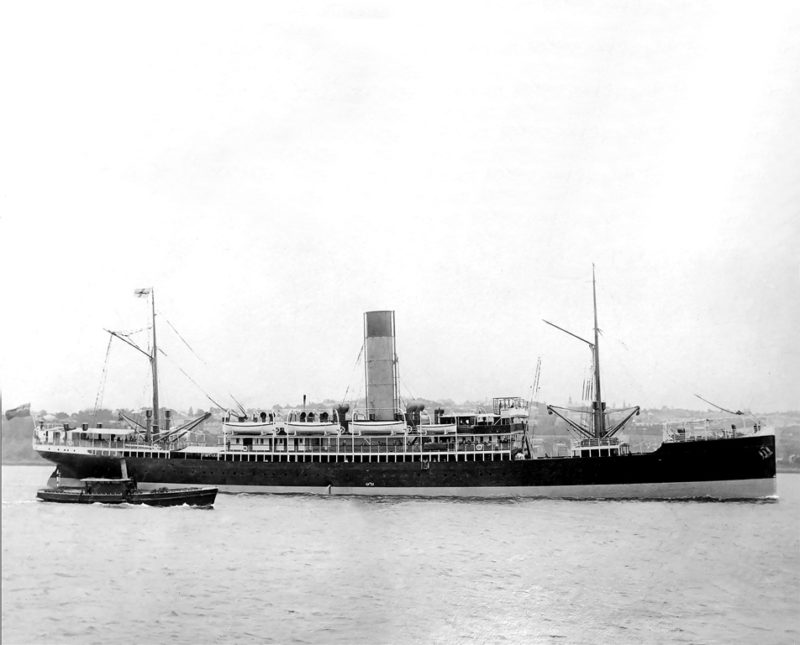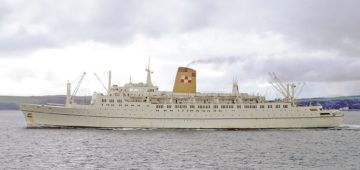
In 1902 the Adelaide Steamship Company ordered two ships to be built by Armstrong Whitworth & Co. on the Tyne, at a cost of about £102,000 each. They would be almost twice the size of any previous ship owned by the company, incorporate all the latest improvements, and provide superb accommodation for 240 passengers.
The first vessel was launched on 29th April 1903 and named Yongala, the name of a small town in South Australia and an aboriginal word for a watering place. Trials commenced on 30th September, with a maximum speed of 15.8 knots being achieved, well in advance of the contract speed of 14.5 knots. As completed, Yongala was 3,664 grt, 363 feet long with a beam of 45 feet, and could accommodate 110 first class and 130 second class passengers.
For its delivery voyage to Australia, Yongala was chartered by the Union-Castle Line to carry passengers to South Africa, departing Southampton on 9th October 1903 under the command of Captain J. Sim. After calling at Las Palmas to take on bunkers, Yongala arrived in Capetown on 2nd Novem-ber, leaving on 9th November to continue to Durban. After disembarking all the passengers bound for South Africa, a number of Australians were embarked to be taken home.
Yongala arrived at Fremantle on 23rd November, spending three days in port before departing for Adelaide fifteen minutes after the 6,077 grt Orizaba, operating for the Orient Line, also left for Adelaide. It was generally believed the ships would engage in a race across the Great Australian Bight, and although this was denied by the owners of both ships, when Yongala reached Adelaide on 30th November several hours ahead of Orizaba that fact was widely reported. Yongala went on to Melbourne, arriving on 3rd December, and berthed in Sydney on 6th December, spending the next four weeks there being prepared for the coastal service.

The arrival of Yongala in Australia attracted considerable attention, and a description of the ship that appeared in numerous newspapers included the following:-
She has a poop, forecastle, and long citadel house amidships, and an island deck is arranged in way of the foremast. The deck above the citadel house is carried out to the ship’s side, and forms a spacious and airy promenade, on which is placed a tier of deckhouses, containing drawing-room, saloon, entrance, staterooms, and smoking-room. Above this again is the boat deck, upon which are placed the captain’s room and chartroom, wheelhouse, with living bridge above.
Entering from the promenade deck large doors’ give access to an entrance lobby, from which folding doors open into the drawing-room, and a wide staircase leads down to the dining saloon. The staircase is further continued into a large space below the saloon which has been arranged as a dining-room for children. This room is surrounded by first-class staterooms, and two passages leading aft on either side of the machinery casing give access to the whole range of passenger accommodation, which occupies the full length of the ‘tween deck to the stern.
As the climate in which the vessel is to trade is hot, special attention has been paid to the ventilation, not only in the staterooms themselves, but all the passages and alleyways into which they open, and powerful electric fans are fitted in the engine room, and air trunks are led to all the living spaces.
In the ‘tween decks the passages terminate at their after end in a hall, from which a staircase gives access to the second-class drawing and dining saloons. These rooms are fitted in teak and mahogany respectively, the upper panelling being enamelled white in each case. The drawing-room contains a Broadwood piano. Divisions are arranged in these passages so that a larger or smaller number of staterooms can be used as second-class as may be required, and the doors are arranged so that the second-class rooms may be completely shut off from the first-class! The promenade-deck is exceptionally roomy, and provides well sheltered seating accommodation, which will no doubt be found acceptable by the passengers. Special staterooms are arranged round the engine hatch on the promenade deck, and at the after end there is a large smoking-room, with bar and lavatory openings off it

Subscribe today to read the full article!
Simply click below to subscribe and not only read the full article instantly, but gain unparalleled access to the specialist magazine for shipping enthusiasts.





Comments
Sorry, comments are closed for this item